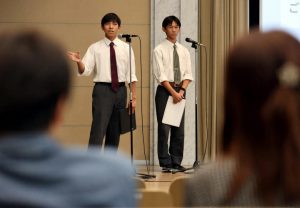Special feature series — Nihon Hidankyo awarded Nobel Peace Prize, Part 3: Carrying forward survivors’ memories to younger generations is urgent task for nuclear-free future
Oct. 14, 2024
Regional A-bomb survivors’ organizations continue to dwindle in number
by Michio Shimotaka, Staff Writer
On October 12, the news that Nihon Hidankyo (Japan Confederation of A-and H-Bomb Sufferers Organizations) was awarded the Nobel Peace Prize reverberated widely in Japan and overseas. On the same day, a civic lecture that the Hiroshima City government had organized to provide citizens the opportunity to consider nuclear and peace issues was held at the Hiroshima Peace Memorial Museum, located in the city’s Naka Ward.
In front of an audience of around 70 participants, Ren Okada, 18, and Rei Morita, also 18, who are both third-year students at Funairi High School, presented their experiences of attending a preparatory committee meeting for the Nuclear Non-Proliferation Treaty (NPT) Review Conference held in Geneva, Switzerland earlier this year in July and communicating with people of the same generation from around the world. Seemingly inspired by the Peace Prize awarded to Nihon Hidankyo, the two recalled their experiences and said, “We have no concern that we are without allies in the aim to achieve a peaceful world.”
In a statement that included its reasoning for awarding the prize to Nihon Hidankyo, the Norwegian Nobel Committee praised the group’s activities over many years. “New generations in Japan are carrying forward the experience and the message of the witnesses. In this way they are helping to maintain the nuclear taboo – a precondition of a peaceful future for humanity.” The committee gave high marks to the group’s unceasing efforts in the A-bombed cities to make sure the survivors’ stories do not fade from memory.
Hideo Asano, 27, secretariat of the Japan NGO Network for Nuclear Weapons Abolition (JANA), a general incorporated association located in Tokyo, spoke at the lecture and shared his views. “I think the award decision was made because a sense of crisis is spreading around the world about how to pass forward the wishes of the A-bomb survivors (hibakusha) to future generations.” Ms. Asano’s organization was established in April this year based on a liaison meeting held between Nihon Hidankyo and other peace organizations. The group has repeatedly called on politicians and citizens to urge Japan’s national government to join the Treaty on the Prohibition of Nuclear Weapons (TPNW) by 2030.
The average age of the A-bomb survivors now exceeds 85 years. Eleven of the prefectural A-bomb survivor organizations throughout Japan that make up the Nihon Hidankyo organization have been disbanded or suspended their activities. Local survivors’ organizations in Hiroshima Prefecture are shutting down one after the other. The number of A-bomb survivors applying to communicate their experiences in the atomic bombing to the public at the Hiroshima Peace Memorial Museum under a program run by the Hiroshima City government is also on the decline. It is only natural that activities engaged in by the A-bomb survivors themselves diminish year by year.
At a press conference held in Tokyo on October 12, Nihon Hidankyo’s directors were asked about the current situation regarding A-bomb survivors’ organizations. In response, Masako Kudo, chief of the organization’s administrative office who has offered his support over many years, did not hesitate to voice his concerns. “A-bomb survivors have fought against the ‘acceptance theory’ (which insists that war damages should be borne by citizens equally) and pursued a world without nuclear weapons and wars. Is it really acceptable for us to rely only on A-bomb survivors to fulfill that role?”
On the night of October 11, the date of the announcement of Nihon Hidankyo’s selection as recipient of the Peace Prize, three high school students in Hiroshima Prefecture sat next to Toshiyuki Mimaki, 82, co-chair of Nihon Hidankyo and chair of the Hiroshima Prefectural Confederation of A-Bomb Sufferers Organizations (Hiroshima Hidankyo), and shared the joy of receiving the prize at a press conference held by Mr. Mimaki at Hiroshima City Hall. The students were the 27th High School Peace Ambassadors, a collection of people who has collected signatures seeking the abolition of nuclear weapons throughout Japan, delivering the list to the United Nations, and in recent years was nominated for the Nobel Peace Prize.
One of the ambassadors, Natsuki Kai, 17, a second-year student at Motomachi High School, revealed that someone had told her during the students’ activities that elimination of nuclear weapons “was impossible.” Ms. Kai said, “I want to spread our hopes widely so that people can believe the goal is not a mere dream but something realistic.” To realize a world free of nuclear weapons and wars is a goal shared by all of humanity. With A-bomb survivors acting as a guide, the ambassadors look to a future that needs to be created in concert with people around the world.
(Originally published on October 14, 2024)








